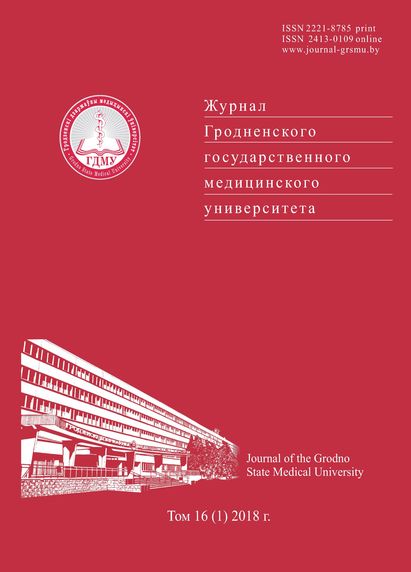ПЕРСПЕКТИВЫ ИСПОЛЬЗОВАНИЯ БИОМАРКЕРОВ (АДИПОНЕКТИНА, Р-СЕЛЕКТИНА, ИНТЕГРИНА βΒ3) В КАЧЕСТВЕ БИОХИМИЧЕСКИХ ПРЕДИКТОРОВ РЕСТЕНОЗА У ПАЦИЕНТОВ С ИШЕМИЧЕСКОЙ БОЛЕЗНЬЮ СЕРДЦА ПОСЛЕ КОРОНАРНОГО СТЕНТИРОВАНИЯ

Аннотация
Цель: проанализировать литературные данные о роли адипонектина, Р-селектина и интегрина β3 в патогенезе развития рестеноза внутри стента у пациентов с ишемической болезнью сердца после коронарного стентирования, а также возможности использования перечисленных биомаркеров в качестве предикторов рестенозирования.
Результаты. Были рассмотрены некоторые аспекты патогенеза развития рестеноза внутри стента у пациентов с ишемической болезнью сердца после коронарного стентирования, в том числе роль адипонектина, Р-селектина и интегрина β3, а также их прогностическое значение.
Выводы. Приведенные данные свидетельствуют о возможной роли адипонектина, Р-селектина и интегрина β3 в патогенезе развития рестеноза внутри стента у пациентов с ишемической болезнью сердца после коронарного стентирования. Однако результаты выполненных исследований, в которых оценивалось прогностическое значение перечисленных биомаркеров в аспекте развития рестеноза внутри стента, носят противоречивый характер.
Литература
Cassese S, Byrne RA, Tada T, Pinieck S, Joner M, Ibrahim T, King LA, Fusaro M, Laugwitz KL, Kastrati A. Incidence and predictors of restenosis after coronary stenting in 10 004 patients with surveillance angiography. Heart. 2014;100(2):153-159. doi: 10.1136/heartjnl-2013-304933.
Mintz GS, Popma JJ, Pichard AD, Kent KM, Satler LF, Wong C, Hong MK, Kovach JA, Leon MB. Arterial remodeling after coronary angioplasty: a serial intravascular ultrasound study. Circulation. 1996;94(1):35-43.
Bauters C, Meurice T, Hamon M, McFadden E, Lablanche JM, Bertrand ME. Mechanisms and prevention of restenosis: from experimental models to clinical practice. Cardiovasc. Res. 1996;31(6):835-846.
Buccheri D, Piraino D, Andolina G, Cortese B. Understanding and managing in-stent restenosis: a review of clinical data, from pathogenesis to treatment. J. Thorac. Dis. 2016;8(10):E1150-E1162. doi: 10.21037/ jtd.2016.10.93.
Scott-Burden T, Vanhoutte PM. The endothelium as a regulator of vascular smooth muscle proliferation. Circulation. 1993;87:V51-V55.
Le Breton H, Plow E, Topol E. Role of platelets in restenosis after percutaneous coronary revascularization. J. Am. Coll. Cardiol. 1996. 28(7):1643-1651. – doi: 10.1016/S0735-1097(96)00417-2.
Kokubo T, Uchida H, Choi ET. Integrin alpha(v)beta(3) as a target in the prevention of neointimal hyperplasia. J. Vasc. Surg. 2007;45(6S):A33-A38. doi: 10.1016/j.jvs.2007.02.069.
Funahashi T, Nakamura T, Shimomura I, Maeda K, Kuriyama H, Takahashi M, Arita Y, Kihara S, Matsuzawa Y. Role of adipocytokines on the pathogenesis of atherosclerosis in visceral obesity. Intern. Med. 1999;38(2):202-206.
Ohashi K, Kihara S, Ouchi N, Kumada M, Fujita K, Hiuge A, Hibuse T, Ryo M, Nishizawa H, Maeda N, Maeda K, Shibata R, Walsh K, Funahashi T, Shimomura I. Adiponectin replenishment ameliorates obesity-related hypertension. Hypertension.2006. 47(6):1108-1116. doi: 10.1161/01.HYP.0000222368. 43759.a1.
Ouchi N, Walsh K. Adiponectin as an anti-inflammatory factor. Clin. Chim. Acta. 2007; 380(1-2):24-30. doi:10.1016/j.cca.2007.01.026.
Stefan N, Vozarova B, Funahashi T, Matsuzawa Y, Weyer C, Lindsay RS, Youngren JF, Havel PJ, Pratley RE, Bogardus C, Tataranni PA. Plasma adiponectin concentration is associated with skeletal muscle insulin receptor tyrosine phosphorylation, and low plasma concentration precedes a decrease in whole-body insulin sensitivity in humans. Diabetes. 2002;51(6):1884-1888.
Iwashima Y, Katsuya T, Ishikawa K, Ouchi N, Ohishi M, Sugimoto K, Fu Y, Motone M, Yamamoto K, Matsuo A, Ohashi K, Kihara S, Funahashi T, Rakugi H, Matsuzawa Y, Ogihara T. Hypoadiponectinemia is an independent risk factor for hypertension. Hypertension. 2004;43(6):1318- 1323. doi: 10.1161/01.HYP.0000129281.03801.4b.
Denzel MS, Scimia MC, Zumstein PM, Walsh K, Ruiz-Lozano P, Ranscht B. T-cadherin is critical for adiponectin-mediated cardioprotection in mice. J. Clin. Invest. 2010;120(12):4342-4352. doi: 10.1172/JCI43464.
Parker-Duffen JL, Walsh K. Cardiometabolic effects of adiponectin. Best Pract. Res. Clin. Endocrinol. Metab. 2014;28(1):81-91. doi: 10.1016/j.beem.2013.09.001.
Kitamoto A, Kitamoto T, Nakamura T, Matsuo T, Nakata Y, Hyogo H, Ochi H, Kamohara S, Miyatake N, Kotani K, Mineo I, Wada J, Ogawa Y, Yoneda M, Nakajima A, Funahashi T, Miyazaki S, Tokunaga K, Masuzaki H, Ueno T, Chayama K, Hamaguchi K, Yamada K, Hanafusa T, Oikawa S, Sakata T, Tanaka K, Matsuzawa Y, Hotta K. CDH13 Polymorphisms are Associated with Adiponectin Levels and Metabolic Syndrome Traits Independently of Visceral Fat Mass. Atheroscler. Thromb. 2016:23(3):309-319. doi: 10.5551/jat.31567.
Arita Y, Kihara S, Ouchi N, Takahashi M, Maeda K, Miyagawa J, Hotta K, Shimomura I, Nakamura T, Miyaoka K, Kuriyama H, Nishida M, Yamashita S, Okubo K, Matsubara K, Muraguchi M, Ohmoto Y, Funahashi T, Matsuzawa Y. Paradoxical decrease of an adipose-specific protein, adiponectin, in obesity. Biochem. Biophys. Res. Commun. 1999;257(1):79-83.
Predictive value of the adipocyte-derived plasma protein adiponectin for restenosis after elective coronary stenting. Jpn. Heart J. 2002;43(2):85-91.
Nishimura M, Hashimoto T, Kobayashi H, Yamazaki S, Okino K, Fujita H, Inoue N, Takahashi H, Ono T. Association of the circulating adiponectin concentration with coronary in-stent restenosis in haemodialysis patients. Nephrol. Dial. Transplant. 2006;21(6):1640-1647. doi: 10.1093/ndt/gfk088.
Shioji K, Moriwaki S, Takeuchi Y, Uegaito T, Mutsuo S, Matsuda M. Relationship of serum adiponectin level to adverse cardiovascular events in patients who undergo percutaneous coronary intervention. Circ. J. 2007;71(5):675-680.
Ohashi K, Ouchi N, Kihara S, Funahashi T, Nakamura T, Sumitsuji S, Kawamoto T, Matsumoto S, Nagaretani H, Kumada M, Okamoto Y, Nishizawa H, Kishida K, Maeda N, Hiraoka H, Iwashima Y, Ishikawa K, Ohishi M, Katsuya T, Rakugi H, Ogihara T, Matsuzawa Y. Adiponectin I164T mutation is associated with the metabolic syndrome and coronary artery disease. J. Am. Coll. Cardiol. 2004;43(7):1195-1200. doi: 10.1016/j.jacc.2003.10.049.
McEver RP. Selectins: initiators of leucocyte adhesion and signalling at the vascular wall. Cardiovasc. Res. 2015;107(3):331-339. doi: 10.1093/cvr/cvv154.
Lawrence MB, Springer TA. Leukocytes roll on a selectin at physiologic flow rates: distinction from and prerequisite for adhesion through integrins. Cell. 1991:65(5):859-873.
Wang K, Zhou Z, Zhou X, Tarakji K, Topol EJ, Lincoff AM. Prevention of intimal hyperplasia with recombinant soluble P-selectin glycoprotein ligand-Ig (rPSGL-Ig) in the porcine coronary artery balloon injury model. J. Am. Coll. Cardiol. 2001;38(2):577-582.
Ozben B, Diz-Kucukkaya R, Bilge AK, Hancer VS, Oncul A. The association of P-selectin glycoprotein ligand-1 VNTR polymorphisms with coronary stent restenosis. J. Thromb. Thrombolysis. 2007;23(3):181-187. doi:10.1007/s11239-006-9020-9.
Ridker PM, Buring JE, Rifai N. Soluble P-selectin and the risk of future сardiovascular events. Circulation. 2001;103(4):491-495.
Bielinski SJ, Berardi C, Decker PA, Kirsch PS, Larson NB, Pankow JS, Sale M, de Andrade M, Sicotte H, Tang W, Hanson NQ, Wassel CL, Polak JF, Tsai MY. P-selectin and subclinical and clinical atherosclerosis: the Multi-Ethnic Study of Atherosclerosis (MESA). Atherosclerosis. 2015;240(1):3-9. doi: 10.1016/j.atherosclerosis. 2015.02.036.
Tardif JC, Tanguay JF, Wright SR, Duchatelle V, Petroni T, Grégoire JC, Ibrahim R, Heinonen TM, Robb S, Bertrand OF, Cournoyer D, Johnson D, Mann J, Guertin MC, L’Allier PL. Effects of the P-selectin antagonist inclacumab on myocardial damage after percutaneous coronary intervention for non-ST-segment elevation myocardial infarction: results of the SELECT-ACS trial. J. Am. Coll. Cardiol. 2013;61(20):2048-2055. doi: 10.1016/j.jacc.2013.03.003.
Jilma-Stohlawetz P, Mannhalter C, Kaider A, Waidacher T, Jilma B, Panzer S. The association of the Thr715ProP-selectin genotype with levels of P-selectin in platelet concentrates. Vox Sang. 2014;107(4):368-374. doi:10.1111/vox.12175.
Selective alpha(v)beta(3)-receptor blockade reduces macrophage infiltration and restenosis after balloon angioplasty in the atherosclerotic rabbit / G. G. Bishop [et al.] // Circulation. – 2001. – Vol. 103, № 14. – P. 1906-1911.
Bishop GG, McPherson JA, Sanders JM, Hesselbacher SE, Feldman MJ, McNamara CA, Gimple LW, Powers ER, Mousa SA, Sarembock IJ. Selective alpha(v) beta(3)-receptor blockade reduces macrophage infiltration and restenosis after balloon angioplasty in the atherosclerotic rabbit. Сirculation. 2001;103(14):1906-1911.
Preparation, characterization, and evaluation of a monoclonal antibody against the rabbit platelet glycoprotein IIb/IIIa in an experimental angioplasty model / M. A. Azrin [et al.] // Circ. Res. – 1994. – Vol. 75, № 2. – P. 268-277.
Azrin MA, Ling FS, Chen Q, Pawashe A, Migliaccio F, Homer R, Todd M, Ezekowitz MD. Preparation, characterization, and evaluation of a monoclonal antibody against the rabbit platelet glycoprotein IIb / IIIa in an experimental angioplasty model. Circ. Res.1994;75(2):268-277.




























